How To Become Your Child’s Emotion Coach With These 5 Steps
Inside: Learn how to become your child’s emotion coach. This benefits both you and your children as they increase their emotional intelligence. Scroll down to sign up to get your free emotion coach printable.
What I’ve come to realize over the last ten years of my parenting journey is that the single most important thing my children need from me is emotional support. Not only to be understood but also to be taught social and emotional intelligence skills.
This post contains affiliate links, see disclosure policy for details.
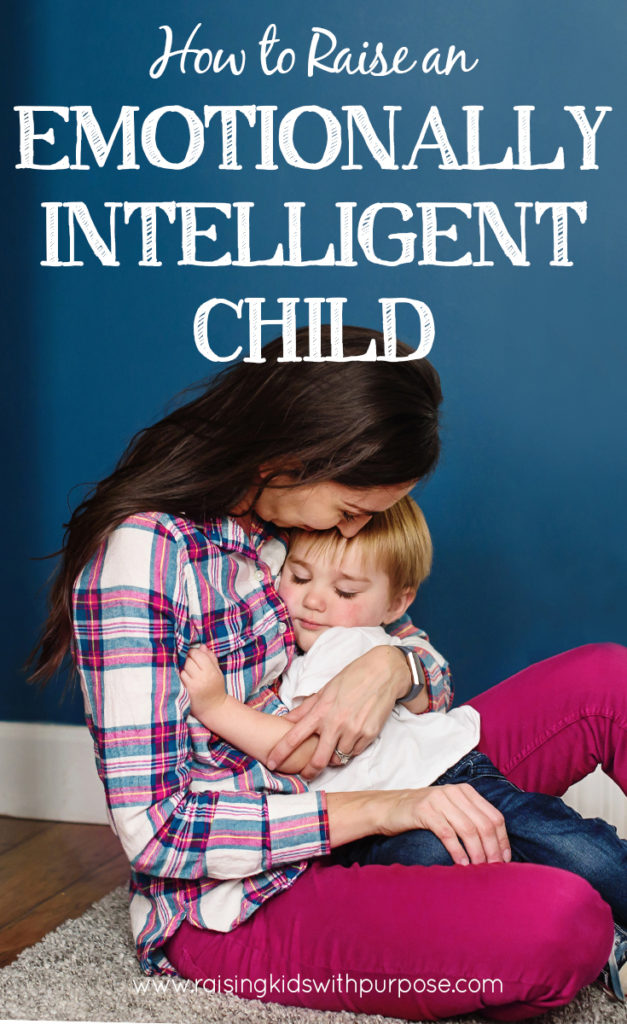
After reading countless books and listening to even more podcasts, I found that the common theme of successful child-rearing is creating a strong connection through understanding my own emotions first.
Once I can process my own emotions, then the second most important thing to do is to support how my child feels.
Regardless of the parenting style or philosophy, emotional intelligence is where it’s at. Don’t believe me, check out Generation Mindful! What they are doing to help kids increase emotional intelligence is INCREDIBLE!
Today, we know so much about the growing brain from neuroscience and behavioral research. There are longitudinal studies that span over 40, 50, 60 years! And with the help of technology such as Functional MRIs, we have concrete evidence of what’s happening with neural pathways during brain development.
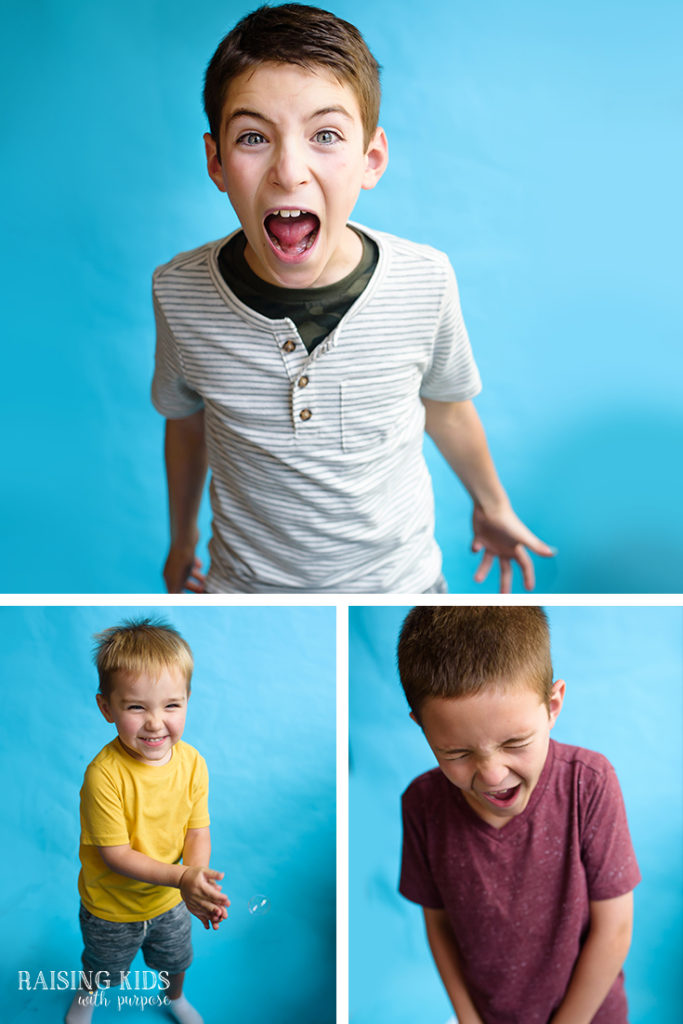
Table of Contents
The Importance of Emotional Intelligence and How to Teach It To Your Child
Experts continue to gain very valuable knowledge about how people develop into resilient, competent adults who have high emotional intelligence.
How have we gone so long without realizing that emotions are healthy?
In the past, at least here in the United States, it was common for kids to not be treated like emotional beings. Instead, they were to be seen and not heard.
Denmark has been ranked as having the happiest people in the world for the past 40 years. If you take a deep dive into how they raise their kids, you’ll learn that empathy is deeply rooted in their values. There is not much shaming, blaming or frustration over unhappy feelings. And they instinctively start teaching empathy as soon as a child is born.
Read Next: Spend Quality Time With Your Kids
Emotional Intelligence
Dr. John Gottman, a psychologist who specializes in this field, states that research shows the biggest indicator of a child’s future is his or her relationship with others.
And that relationship starts with his or her parent.
By definition, emotional intelligence means, “The capacity to be aware of, control, and express one’s emotions, and to handle interpersonal relationships judiciously and empathetically.”
Whoah! That is loaded!
Here Are the Five Components of Emotional Intelligence:
- Motivation
- Empathy
- Relationship & Social Skills
- Self-Regulation
- Self-Awareness
Emotional Intelligence (EQ) is so important because it allows humans to flourish. It opens a door to better learning, relationships, understanding of others, academic achievement and eventually employment success. Psychologists even debate if EQ is more important than IQ.
Regardless, it’s something to pay attention to especially in raising kids. Even though some kids naturally have a higher EQ than others, it’s invaluable to focus on cultivating it in children so they can carry those skills into adulthood.
This can be done with a simple mind shift.
If your child struggles with big emotions, check out this Calm Down Toolkit to help him or her self-regulate.
It’s Not Only About Compliance
Since reading “The Whole-Brain Child” by Dr. Daniel Siegel, my eyes were opened to this world of connecting with my child on an emotional level. I had already figured out that punishment was not the most effective form of discipline, but connecting the dots with how the young brain develops was life-changing for my and my husband’s parenting approach.
A Tough Concept for Some
I do have to say that at first, this was a very hard concept for my husband to grasp. He was a firm believer that kids need consequences for every single mistake they make or when they display any kind of defiant behavior because “kids should be compliant.”
In fact, I can remember a situation where I was trying to put this knowledge into place and my husband was not having it.
We were walking home from the grocery store when one of my boys said or did something that appeared to be very disrespectful. I suggested we need to connect and then redirect as I had just learned.
Immediately, my husband glared into my eyes and asked, “You mean, I just let him get away with that behavior? I’m supposed to be kind to him when he just spoke to me like that? How will he ever learn?”
He often felt like they just “never listened.” The reason for this is that he wanted to control their behaviors right then and there versus allowing them to grow and learn from the situation. His thinking was understandable as it is a very common way for parents (and many teachers) to think.
Also, our boys may have seemed like they weren’t listening, but what they were really doing was fighting for autonomy. This is one of our basic psychological needs as humans, to feel like we have control over our own lives, and yet, children have very little.
Read Next: Give Your Child the Responsibility of Packing Their Own Lunch!
Fast forward a few years and I learned that, in order for my husband to want to collaborate in parenting, I needed to stop telling and focus on supporting him and modeling how to connect with our boys. And secondly, we learned together that we don’t even need to correct those behaviors anymore because either they don’t happen or our kids self-correct.
We now know that our kids’ “disrespectful” talk is typically their stress response especially for our oldest. If we connect first, our boys will correct their own actions and most likely not repeat it in the future. That is a much better goal than only focusing on compliance at the moment.
It’s important to note that “stress response” behavior is not intentional like we usually assume. Instead, it’s out of their control which is why it’s even more important that we connect and take the opportunity to teach.

The Importance of Connection
As our boys have developed, we both realize the importance of connection and attuning to our children’s emotional needs. In fact, we’ve seen such a transformation and the fruits of this thinking, that this is one of the main reasons I started this blog.
I want to help other parents see past the behaviors and make strong connections with their kids. Because if a parent-child relationship is strong, that child is more likely to grow into a mentally and emotionally healthy adult.
Wouldn’t you agree that we need this more than ever now?
How To Become Your Child’s Emotion Coach With These 5 Steps
Recently, I came across the concept of Emotion Coaching.
It’s basically what we have been doing with our kids with all the research-based knowledge I’ve gained. I love how easy the steps are easy to remember and more importantly, implement.
Created by Dr. John Gottman of The Gottman Institute and author of “Raising an Emotionally Intelligent Child The Heart of Parenting”, this concept teaches parents how to raise emotionally intelligent children.
The Five Steps to Emotion Coaching:
- Be aware of emotions
- Realize when a child is showing emotions that it’s an opportunity to connect
- Help your child put a name to his or her emotions
- Communicate empathy and understanding
- Set limits and problem solve
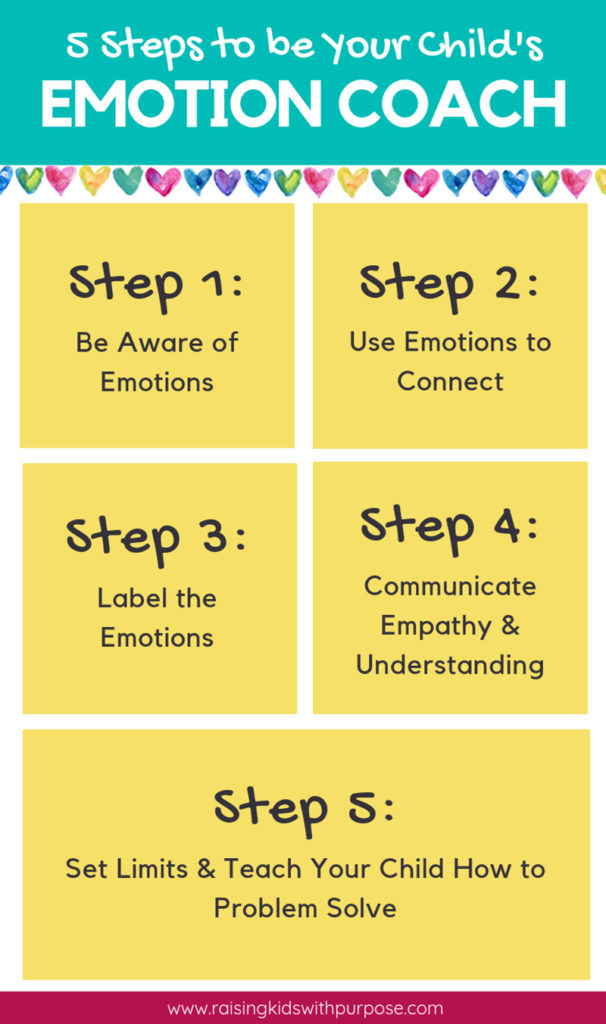
I broke down each step so you can utilize this process in your own relationship with your kids:
Step 1: Be Aware of Emotions
All emotions are healthy. A great way to divide them is by acknowledging feelings that are uncomfortable and comfortable instead of good and bad.
In any relationship, there are two sets of emotions: one from each party. You have your bag of emotions, perceptions of the world, and feelings…
and so. does. your. child.
It’s very important that you are aware of yourself, first.
7 Ways to Work on Your Own Big Feelings:
- Mindfulness Practice
- Wheel of Awareness
- Body Scan
- Go for a walk and draw your attention to the beauty in what you hear and what you see
- Write in a Journal
- Use Coloring Books
- Pray
- Relinquish Control
- Be Aware of Your Triggers
- Use Healthy Self-Talk and Positive Affirmations
Read Next: Start Off Your Mornings With the Right Intention
Once we are aware of when we hit our stress response (fight, flight or freeze) and become either angry, frustrated, sad, or distant, we can acknowledge those feelings. Having a big feeling is totally okay, but it’s what we do with those emotions that matter in our own and our children’s lives.
What To Do with Heightened Emotions
By using some of the strategies listed above, we can be fully aware of when we’re feeling unhappy. In order for our kids to learn how to be in control of their own emotions, we must model and do the same ourselves.
Have you ever found yourself yelling, “Why are you yelling and being so rude to me?” I know I have! But do you see the irony?
There are going to be times when our heart rates just won’t come down.
This may be because we didn’t get emotion coaching as a child and there is something metaphorically blocking the gateway from our stress response to the thinker part of our brains. Being aware of this blockage can help reroute neural pathways. And if we really can’t get it together in the moment, that’s okay! Instead of lashing out either verbally or physically, do this one thing…
FOR YOU! You can download a free Emotion Coach Printable when you sign up for the Raising Kids With Purpose Newsletter
STOP!
(and if you need to, leave the room to calm down)
Dr. Laura Markham of Aha! Parenting teaches parents to Stop, Pause and Breathe. I’ve adapted it a little to Stop, Pray and Breathe.
When stuff hits the fan and I’m ready to go into battle, before even entering the battlefield, I stop. Well, let’s be real, this is my goal.
Secondly, we need to be attuned to our kids’ emotional needs. When they are displaying a certain feeling, it is most beneficial if we realize that their emotions may be expressed differently than ours. Also, because of their underdeveloped brains, they may not be able to regulate as quickly and easily.
It’s very common for kids who are neurodiverse to have challenges in this area. So by being aware that certain emotions are out of the child’s full control, we can move on to the next step with confidence and a gentle state of mind.
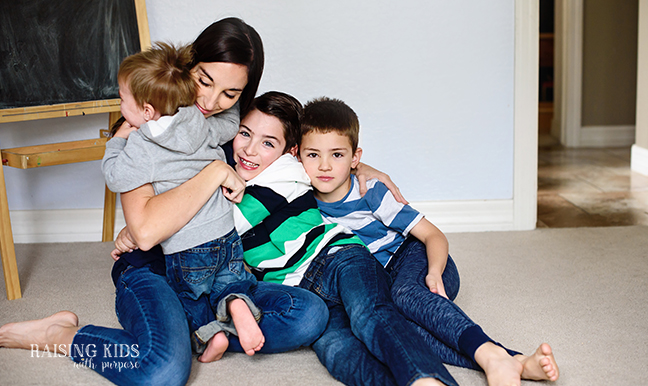
Step 2: When A Child is Emotional, Acknowledge it is a Time to Connect
Kids get upset.
Their little brains have a lot to learn when it comes to regulating emotions. When they are crying or angry, it’s not usually a time when parents see it as an opportunity to connect. But by understanding what emotions are, it’s one of the best times to show a child he or she is loved and cared for.
Strong parent-child relationships happen when there is caring communication so that a healthy attachment can form. If a child feels anything but loved every time he or she shows emotion, the relationship with that parent will slowly turn into a fear-based one or it will grow apart.
In order to achieve this, contingent communication should be the goal. I just read Parenting From the Inside Out by Dr. Daniel Siegel and Mary Hartzell. They say, “Signals sent by the child are directly perceived, understood, and responded to by the parent in a dance of communication that involves mutual collaboration.”
Both parties feel good. This is at the heart of a strong parent-child connection.
Emotional distress occurs when a person does not receive the communication he or she needs. It’s very confusing to a child if he is feeling one way but his parent is on a different page because kids require connection. When this happens, kids tend to not open up as much in fear that they won’t be understood.
You may not have grown up in a house where the focus was on connection but rather, correction and compliance. That’s a whole lot of c’s!

In No-Drama Discipline (another book I highly recommend!) by Dr. Tina Payne Bryson and Dr. Daniel Siegel, they give specific ways to connect with a child and I’ve found some other ways to achieve this.
10 Ways to Use Your Children’s Emotions to Connect With Them:
- Stop, Pause and notice the child’s emotions and how they are acting before jumping in immediately.
- Actively listen to your child. Fully listen without making assumptions or formulating a response to fire back.
- Get on or below your child’s eye level.
- Lovingly touch his or her arm while communicating.
- Show sincere non-verbal empathic facial expressions.
- Nod in an agreement or even if you don’t agree, show that you are trying to understand his or her point of view.
- Validate your child’s feelings by acknowledging how they feel and you can even give a time when you felt the same exact way (if their emotions aren’t too out of control and they are in a teachable state).
- Use reflective listening – summarize what you hear your child saying and repeat it back to him or her.
- Once the dust has settled, savor your time together.
- Be fully present and eliminate distractions.
Read More: Find time to spend quality time together to create an even stronger connection
Step 3: Teach Your Child How to Name His or Her Emotions
Emotions are something we are constantly pointing out in our family. Even our toddler is aware of when a baby is sad or his brother is angry.
The first step to emotional intelligence is to be able to name what a specific emotion is. Once kids have the language to attach to how they feel, it can help them work out those feelings and have a healthy relationship with emotions.

Psychologist Robert Plutchik developed a wheel of emotions that stem from these eight basic emotions:
- Joy
- Sadness
- Anger
- Fear
- Surprise
- Anticipation
- Trust
- Disgust
This is a great place to start. Then once they have these down, you can move on to even more emotions. Check this bad boy out (Robert Plutchik’s Wheel of Emotions):
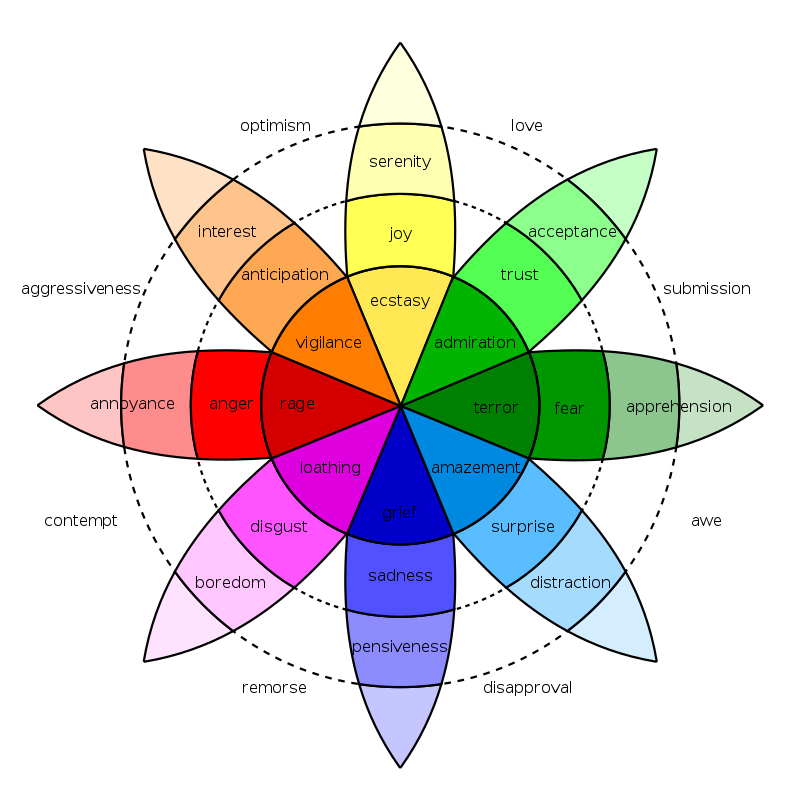
In fact, when a child can label his or her emotions, he or she is less likely to turn those feelings into physical aggression. Saying, “I’m angry” is the first step to not using hands to express that same emotion.
8 Fun Ways to Help Kids Label Emotions:
- Alphabet Game | This can be played anywhere. You go through the alphabet and try to come up with an emotion that starts with that letter. I’ll start, “A is for Affectionate.” Now it’s your turn!
- Use Books! | While reading to your child, point out characters in the book and ask questions like, “How do you think she is feeling?” “Look at his face, is he happy, sad, angry or afraid?”
- Read Books That Teach Social-Emotional Intelligence | There are some great books out there about feelings, empathy and being socially aware for all ages.
- People Watch | I do this mainly with my toddler, but anytime there is another toddler or baby crying or laughing, I ask my little guy, “How is she feeling right now?”
- Color by Number | A friend of mine got coloring sheets from the Dollar Spot at Target that teach emotional intelligence! There are colors assigned to different emotions. Then, every day, she discusses with her daughter how she feels. She picks an emotion and colors one section of the picture. At the end of the month, she could see all the different emotions she was feeling. What a great way to bring emotional awareness!
- Watch and Pause | Watch a show together and randomly pause it. Point out the characters and ask what kind of emotion they are displaying.
- Big Life Journal | Learning to journal while kids are young is a great way to get in touch with what’s going on inside.
- Draw Emotions | Use a coloring sheet to teach your kids how to draw different facial expressions.
Step 4: Communicate Empathy and Understanding
Children do best when they feel like they have ideas that are valued, they can solve their own problems and they know you trust in their abilities.
And don’t we all just want to be loved and feel understood?
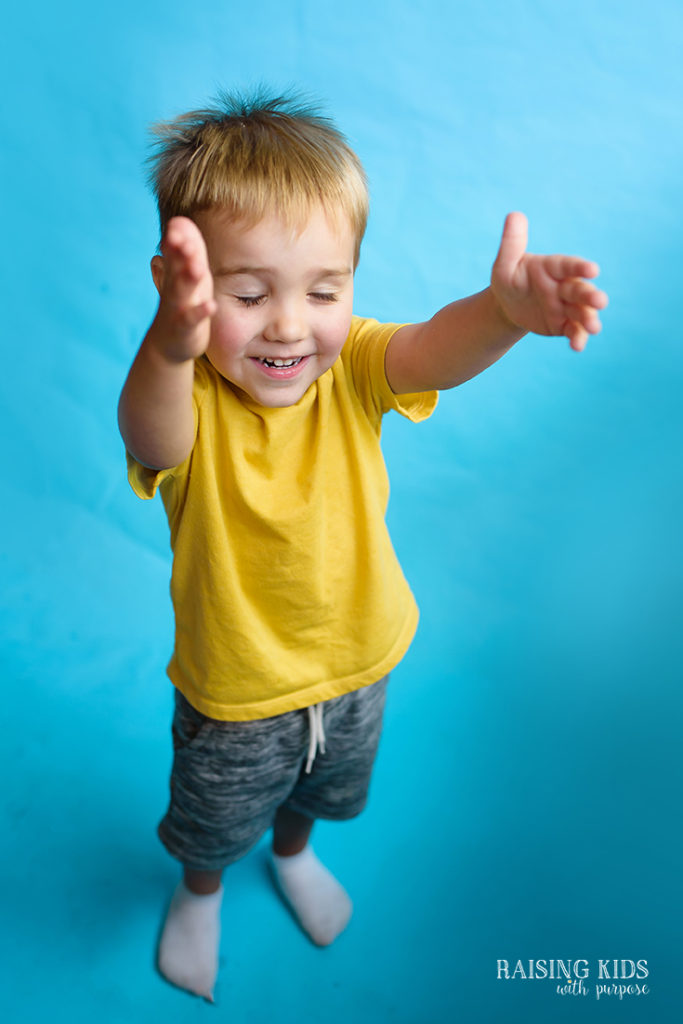
We can feel like we are pouring all this love on our kids but if they don’t also feel like we get them, there’s a missing link.
When a child is lashing out or not acting in a way you would like, there’s this common thinking that validating his or her feelings mean you are giving in or allowing the child to get away with something. After reading about the brain, neurotransmitters and how neural pathways are formed, this thinking is incorrect. And I see it in my own home every day.
Understanding feelings is not condoning defiant behavior.
It’s MUCH easier for a child to behave in an appropriate manner or follow rules if they feel validated.
What has helped me is putting myself in my child’s shoes and asking, “Would I like it if someone spoke to me that way or downplayed my beliefs?”
Oftentimes, we unintentionally treat kids in a way that we would never want to be treated especially when we are experiencing uncomfortable emotions.
Here are a Few Ways Your Child Will Feel Like You Care:
- Acknowledge feelings without judgment. We need to keep our own opinions as opinions. Allow your child to make her own decisions.
- Share the message that the way he is feeling is not only okay but accepted. It’s as if you give your child permission to experience whatever emotion he has at the time.
- Be sensitive to his or her feelings. Don’t brush off how he or she feels just because you think it is silly or it doesn’t make any sense to you.
- Once you show them you are aware of how they are feeling, connect with how you have felt that way one time. This piece has been very helpful with my kids.
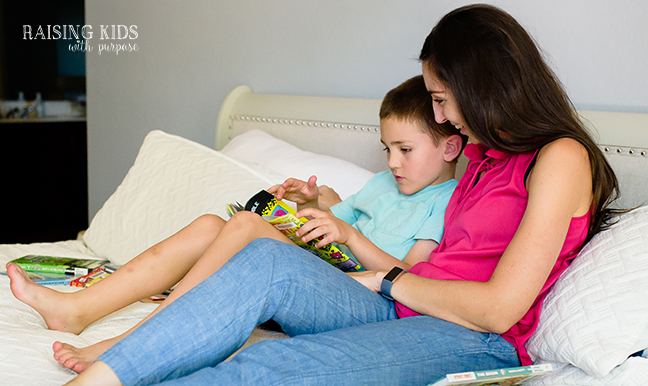
Step 5: Set Limits and Problem Solve
This one is my FAVORITE piece for developing emotional intelligence!
Over time my kids have started coming up with solutions without my help making me realize how important this is to teach.
Because I’m a control freak, I naturally want to come in and solve my kids’ problems for them. If we do this too much, they become unable to see problems and are unable to work through them without your help. Then they get to adulthood and every slight problem is an astronomical crisis. Do you know anyone like that?
Also, teaching kids how to solve their own problems gives them self-confidence, and makes them more independent which essentially makes them feel good about themselves, helps them become more creative and develop grit.
Great Ways to Help Your Child Problem-Solve:
- Redirect | This is a superpower especially with toddlers! Redirect them for behavior that is unwanted not emotions that are uncomfortable.
- Show Me The Hard Part | By asking your child to show you the hard part, it gets her to think about what she has to overcome or solve.
- Teach Your Kids Problem-Solving Steps (These come from Big Life Journal)
- What am I feeling?
- What’s the problem?
- What are the solutions?
- What would happen if…?
- Which one should I try?
- Ask questions to get your child thinking
- How can you solve this?
- I see you have a problem, can you think of three ways that would fix it?
- If you do _________, what do you think would happen?
- How can I help you? This one is often a winner!
- Break problems into pieces | Help your child come up with ways to solve each piece of the puzzle.
Last Step
The last step to emotional intelligence is to love your children hard.
In your actions and words, communicate to your kids that you are on their side. You want them to succeed and you are doing your best to understand and respect their thoughts and feelings, not forcing them to be who you want them to be.
I love the word “coach” because that implies that we have skills and lessons to teach.
This is a lot of information so I created a printable with all the nuts and bolts that you can hang in your office or on the fridge!
Comment below if you have any questions! Thank you for joining me on your parenting journey.



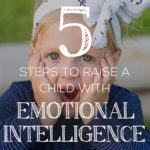



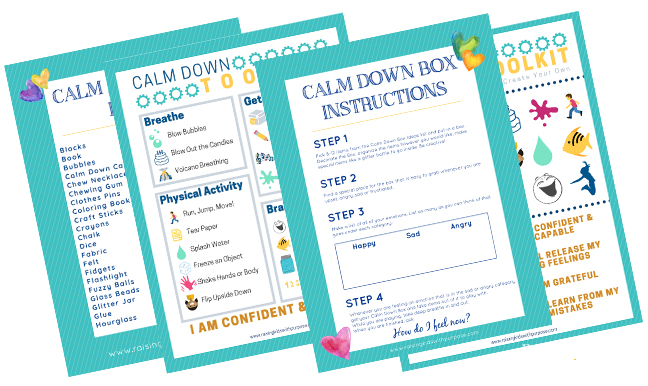
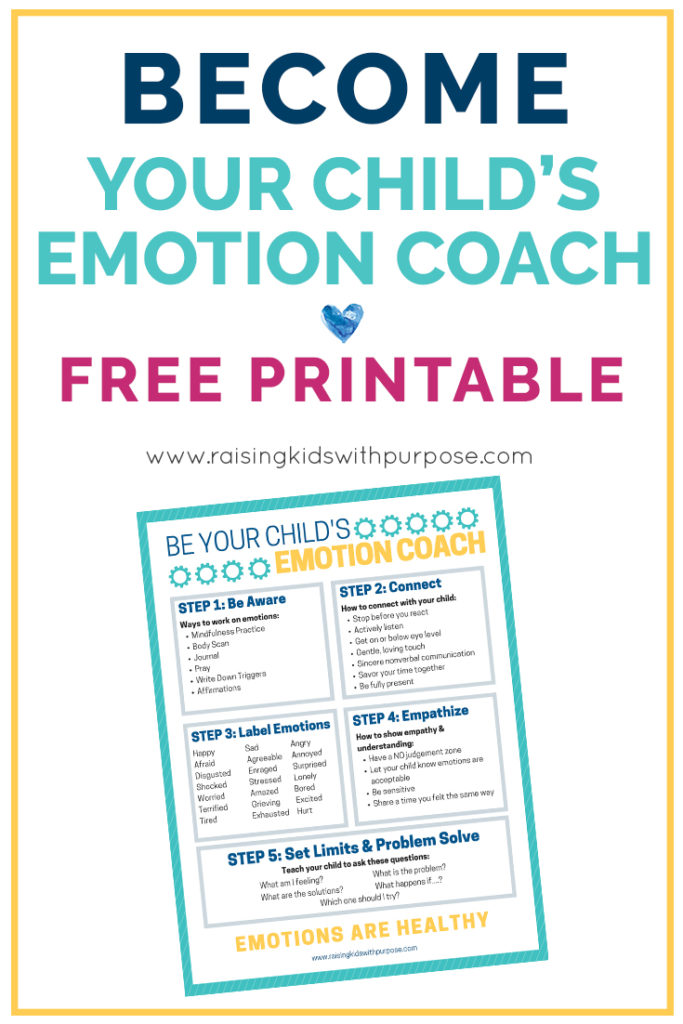
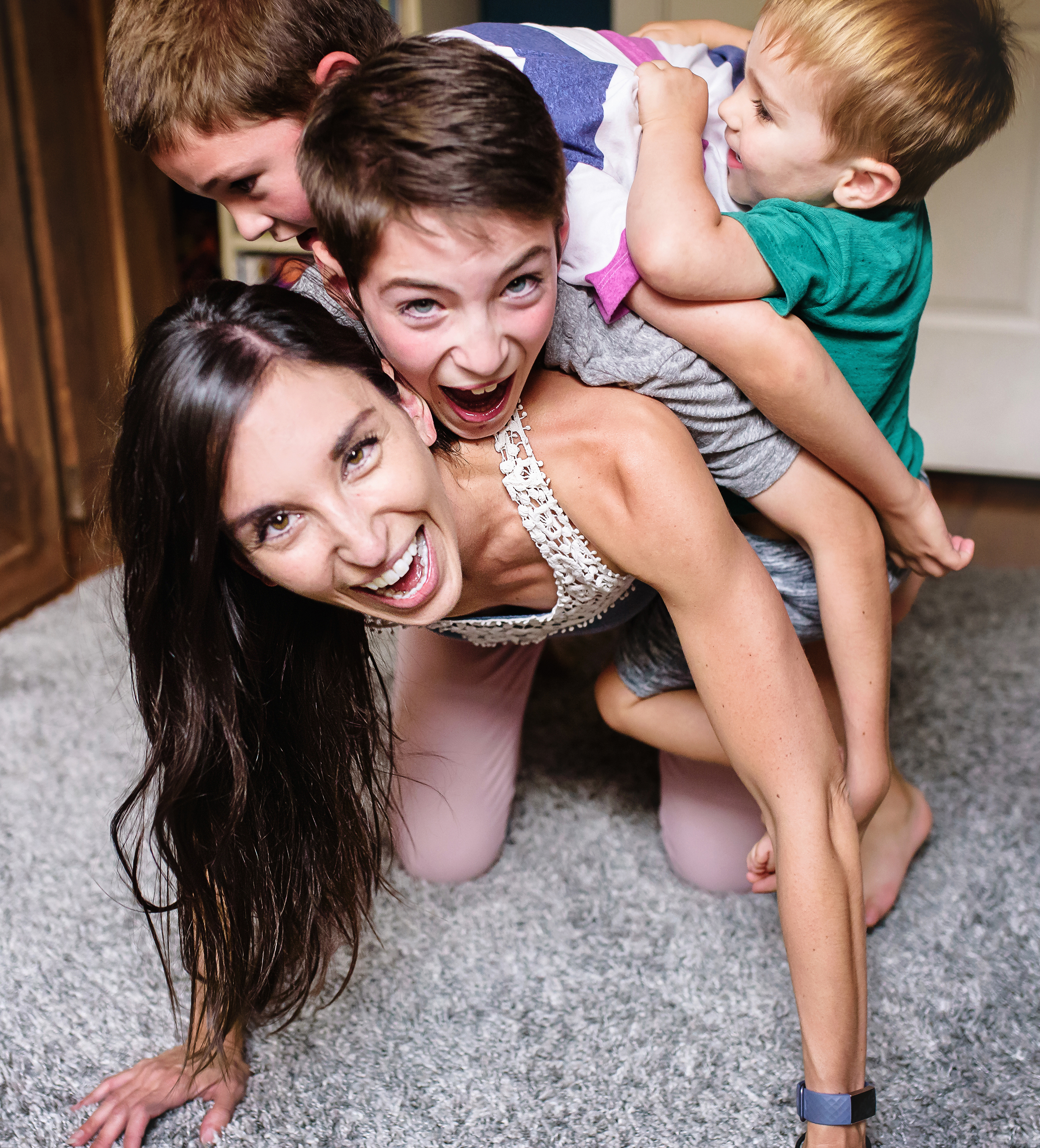
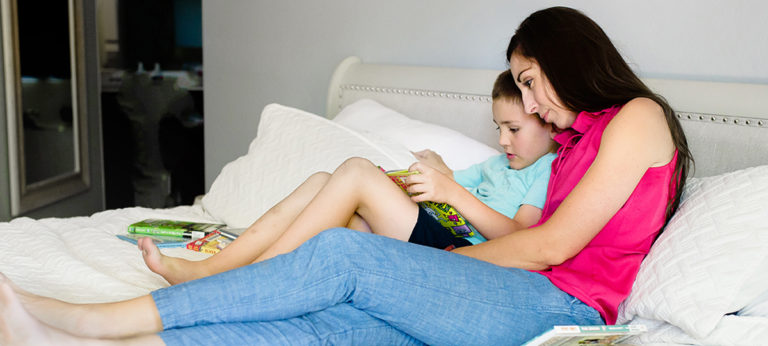
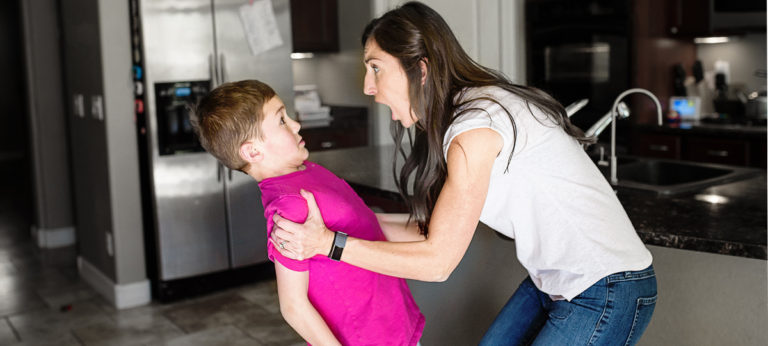
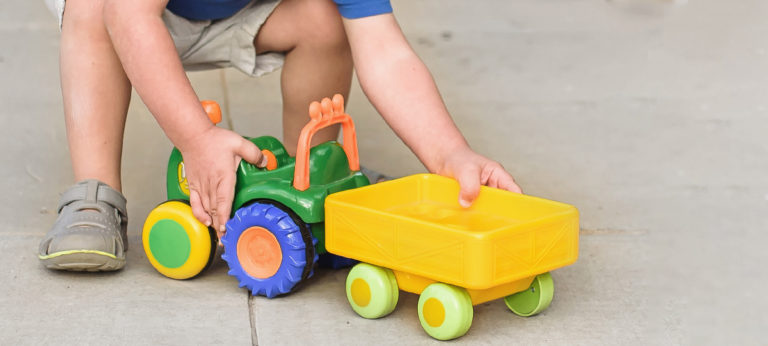



I love this article! My youngest has always struggled to regulate her emotions and big feelings, and it’s been a challenge for my husband and I. Lots of good info here – we’ve found that touch, specifically, is something that she responds to. In the moment, giving her a hug and then stepping into a discussion (which may/may not involve consequences) helps everyone keep their cool!
That is so great that you are attuning to what she needs. I want to dive deeper into sensory needs that kids need especially when they have heightened emotions. We threw glow sticks in the bathtub last week after an epic meltdown from my seven year old. Instant calm! Dark room, glow from the sticks and Christmas jazz music. LOL! The key is to realize our kids need us most when they have big feelings.
This is a wonderful guide. Very informative.
Thank you! Hope this helps with your parenting journey <3
Adriane,
What a really wonderful, comprehensive write up on Emotional Intelligence. This is something we’ve been learning about the last year or so and as we’ve implemented more of this perspective we’ve seen a HUGE difference in our oldest (he’s 15). Yes, he’s still very much a “teenager” but so many of the “normal” family disrupts I see others have (and we were having) we don’t have anymore. With our toddler, it’s helped me see past him being in his “terrible twos” coming on to being a “threenager” and see him as a person dealing with things he needs my HELP with. It’s grown my heart in parenting so many times over.
It really is so important to understand these things. I think we all know so many “unhealthy” adults, including many of ourselves. I want my kids to grow up and be able to be healthy husbands/wives/parents/people!
Thank you for getting this info out there and in such a thorough, easy to read way! It was pinned immediately to my parenting board and I’m sure I’ll be sharing it on my Facebook too!
Thank you so much for sharing! That’s amazing how you’re seeing a difference with your teen. It also has made us look at our toddler in a whole new way as well. And what you said about “unhealthy” adults is so true. I read a quote a while back that said, we know too much about the brain to raise kids who are emotionally unhealthy adults. It’s just hard to break generational habits like not allowing kids to be kids and only focusing on compliance. Yes, we want our kids to make good decisions but it’s not our job to control their every move. And that won’t work anyways.
Awe thank you so much! I can’t wait to check your site out!
Really love this. I have the Whole Brained Child in my Amazon wish list! I especially love that you broke down some easier emotions to teach your child to name so that they can better express themselves.
Thank you! It’s SUCH A good book! If you have hoopla or overdrive through your library, they may have it for free. This is one I bought though so I could revisit it time and time again! And take notes! LOL. And yes, breaking down the emotions is so key. You can even start with your three month old!
This is an amazing read. It is hard as a parent to recognize the emotional need for kids to work through their emotions. I will take some of these steps into action with my emotionally complex 6 year old! Thank you for the read!
Yes! Awe thanks for the sweet compliment!
This is a great article. I need to read and reread it to process it fully- this is exactly how I’m trying to parent- and it’s hard! But it’s worth it, too. I love seeing my daughter develop emotionally and being able to connect with her. Thanks for the encouragement!
With time, it will become very natural. I’ve been parenting this way for the past three or four years without knowing it was a thing. And wow, it’s so much easier to do with my toddler. You are very welcome!
What a great post, especially for parents with young children. As a teacher, I used redirection often with my 8th graders, which they responded to much better than correction in the classroom.
Thank you! Yes, redirection is key! And to stop controlling kids just to simply have control.
I really enjoyed this! Emotional intelligence when raise kids can be overlooked. Helping them identify what they are feeling and appropriate responses are so important.
I think it’s very overlooked because we can find emotions to be a hindrance. I know I’ve been there in not understanding why my child is crying…again! LOL! But if we realize it’s because their brains are wiring and trying to figure things out, it’s easier to help them develop these skills!
I think it’s very overlooked because we can find emotions to be a hindrance. I know I’ve been there in not understanding why my child is crying…again! LOL! But if we realize it’s because their brains are wiring and trying to figure things out, it’s easier to help them develop these skills!
Adriane, your blog is amazing. This single post alone is so comprehensive and value packed. I really need this info right now as we have just hit 2 years old with my toddler and she is having some big feelings lately. THANK YOU for sharing your passion and expertise! I’m officially a new subscriber and excited to learn from you!
Awe, Traci! What an incredibly thoughtful and sweet comment. Thank you so much! I am happy to have you as a new subscriber and hopefully can continue to give you tools that are helpful. Big feelings are extremely developmentally appropriate; two year olds just need to know what to do with those big feelings!